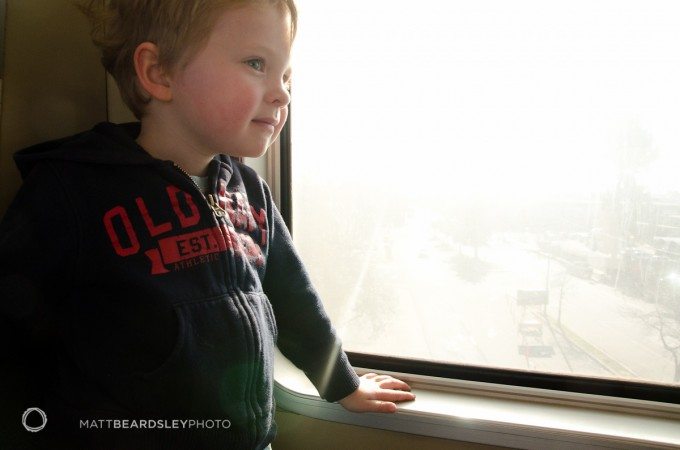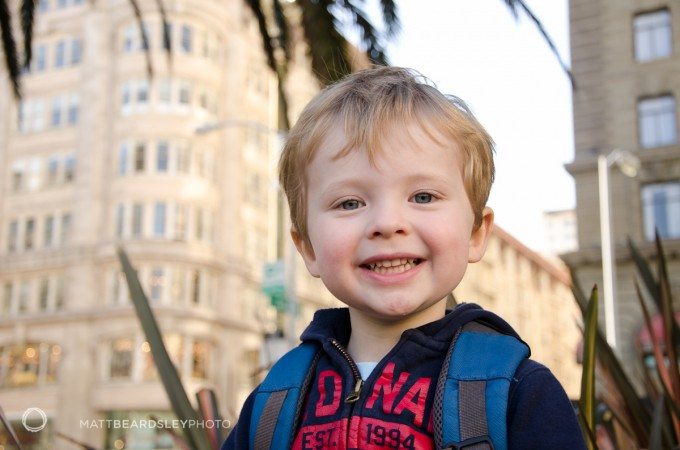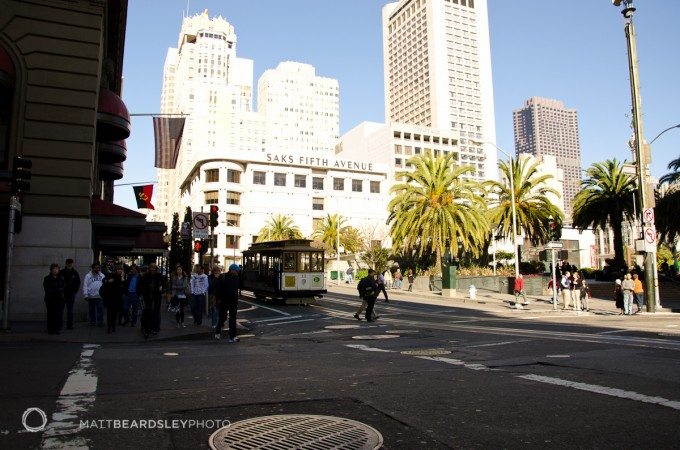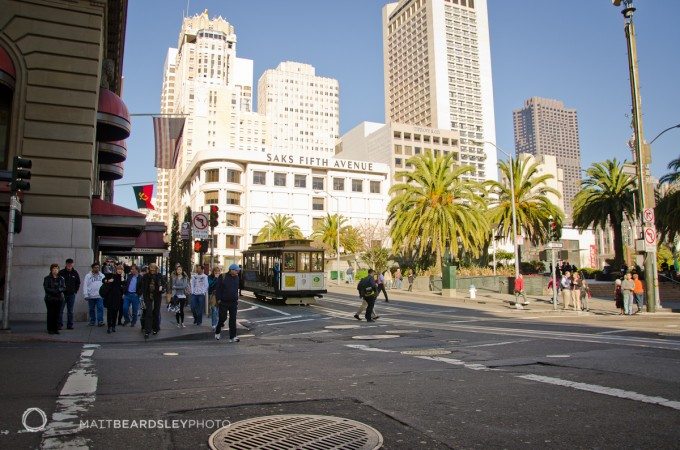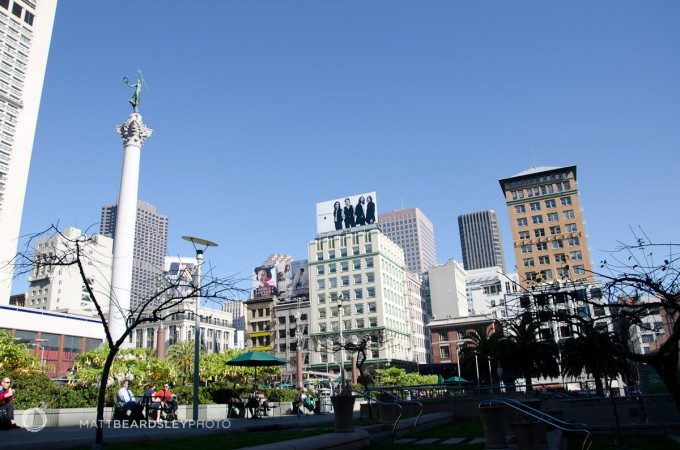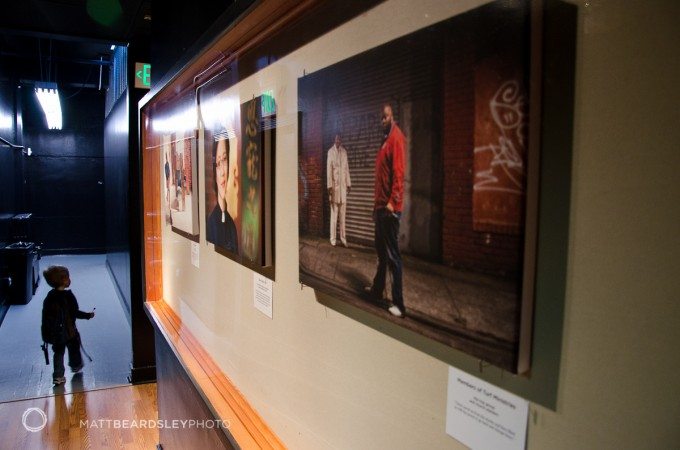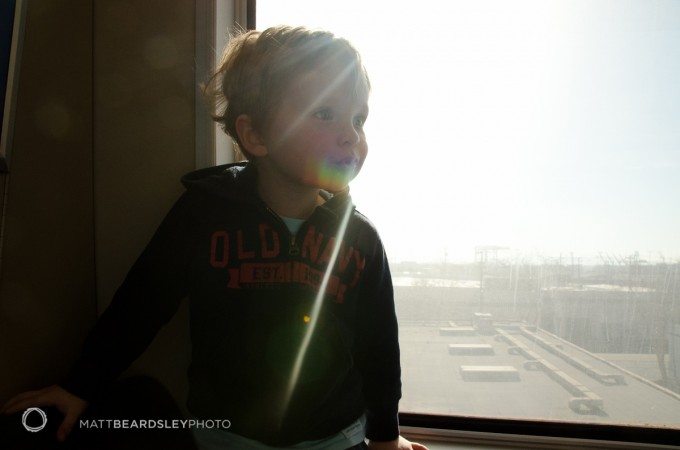The Nikon D7000 is a sturdy camera of modest size (for a DSLR). With easy creative controls, a wide dynamic range, great autofocus, and a wide selection of available lenses, it’ll make a great vacation camera. To the classic Nikon “prosumer” niche (think D70, D80, D90…) the D7000 adds fun, easy, and respectable video recording, with autofocus and optional manual control. It’s a great camera for a day in the city, which is exactly how we’ve tested it on Day 4!
While some of the country is digging out from another snow storm, we had a warm, sunny day in San Francisco. My three-year-old, Joey, and I had to check in on a gallery display of mine, and what better excuse to jump on the BART train and hit the streets around Union Square.
Dynamic Range
The D7000 has fantastic dynamic range. The camera is able to record clean detail from the brightest of scenes to the shadows. It is particularly impressive at low ISO. Take a look at this image, shot in vividly full daylight:
The D7000 did a nice job picking an exposure to average out the very wide-ranging exposure. The brightly-lit buildings were nearly blinding to the naked eye, much less the CMOS, and the foreground is crisply shadowed. This was a RAW capture, processed in Adobe Lightroom 3.0. Take a look at the same file with a few quick adjustments:
Lightroom’s handy tools for exposure: Exposure, Recovery, Fill Light, Blacks, Brightness, etc. etc. make it a quick process to reign in a wild file, to be sure, but, it’s not helpful unless there is detail for which to dig. The D7000 has recorded a terrific range of tones, holding detail on the buildings and the cable car, from two very different exposures.
Autofocus
Autofocus is, perhaps, the Nikon D7000‘s greatest strength when compared to similar cameras from other manufacturers. It is very similar to the high-powered systems in professional Nikons like the D3 I use in my studio. The D7000 actually goes a step further by adding a new setting. The autofocus options are these:
• Manual Focus
• Autofocus, which includes options for:
• Auto Servo Focus (a new setting from Nikon) for allowing the camera to automatically select between Single or Continuous Servo.
• Single Servo Focus, for locking on to something and staying put while you recompose or wait for the right moment.
• Continuous Servo Focus, for tracking a moving subject, the camera doesn’t lock, but stays active right up the “click”
The D7000 has an array of 39 autofocus points. The specific spot on which the camera attempts to focus can be selected from any of these. Moving the point manually, which is an easily accessible option and uses the 4-way rocker on the camera’s back, allows a photographer to select a specific point (for example, a portrait subject’s closest eye) and do less focus-and-recompose. It’s also useful if you have foreground elements you’d like to not emphasize, like tree branches with a beautiful waterfall behind them (cameras tend to grab close subjects if possible
Besides manual point selection, the D7000 offers five methods to select its own point. They are:
• Choose from the middle 9, allowing a wider selection that a single point, but a nice way to avoid focusing on something unexpected (like the tree branches mentioned above).
• Choose from the middle 21, allowing a bit bigger area than the middle 9. This strikes me as a good match for continuous-servo focusing with an active subject, like a pet or child. Objects to either side will be ignored by the autofocus, while the camera tracks the real action).
• All 39 points, All 39 points with 3D tracking, and All 39 points with auto selection of how the points are selected. These three settings make full use of all the camera’s focus points. Nikon’s now established 3D tracking system lets the camera quick track and jump from subject to subject, even as distance from the camera changes drastically. Turning it off gives the camera a brief moment of hesitation while it tries to stay roughly on the same plane. With the full 3D setting engaged, you may never think about focusing again; it works great. It can be distractingly eager to focus on things all over the place, which is why Nikon allows for it to be disabled. The auto setting is provided to allow the camera to decide when things get crazy enough to engage full-tilt 3D tracking.
Live View and Video Autofocus
Regardless of the settings used, the camera does a great job with focus. It is nice to have the option to turn over all control or to keep it all for your creative self. Once in Live View mode, the camera even offers the Face Detection technology Ashton Kutcher has introduced to us all via TV adds for littler Nikons. It works flawlessly on the D7000, locking on to whoever may be in front of the camera and keeping things sharp.
It also works when recording video. Just half-press the shutter release (video recording is engaged using a separate dedicated button). Smartly, a full press on the shutter release, while recording, snaps a still image. While in video record mode, the same autofocus setting button (found in the center of the D7000’s AF/MF switch on the camera’s front) choses between options for the size of the autofocus area and face-detection (front control wheel) and single servo or full-time servo (rear control wheel). The 4-way rocker moves the point and the center OK button re-centers it, just as for still capture operation.
Video autofocus does not use the same sensors as still capture. Once incoming light is directed to the sensor to create Live View and Video image data, the traditional autofocus system is left out. Semi-competitor, Sony, has addressed this issue by creating cameras with a semi-transluscent mirror that direct some light both to the sensor and the autofocus points (like the A-580 we are reviewing). Nikon has tackled the problem, at least for now, by making contrast-detection autofocus, the variety that works by analyzing image data collected by the sensor, work better. And it does work better with the D7000 than ever before, which is good, but still not great compared to the old-school sensors. The AF-F setting, for theoretically tracking moving objects, has a long way to go before it’s anything like the 3D 39-point super-system the camera uses for still image focus tracking. The non-tracking AF-S (auto focus-single-servo) works well and is a welcome addition to video capture (especially if you have an external mic, because autofocus is noisy!)
Note: all images for this post were shot with a Nikon D7000 and its 18-105mm DX VR kit lens
Conclusion, Day 4
The Nikon D7000 is a capable camera, both relatively compact, lightweight, and with a strong feature set. It will make a great vacation camera for families, and will not disappoint serious photographers with its controls, ergonomics, or capture dynamic range. We’ve noticed a bit more grain than expected when shooting at middle to high ISOs, but in good light, the camera does a great job. A particular strength is the D7000’s flexible, customizable, and very effective autofocus system. The camera brings welcome innovation to Live View and Video autofocus and continues to refine Nikon’s already best-in-class still capture autofocus.
Please Support The Phoblographer
We love to bring you guys the latest and greatest news and gear related stuff. However, we can’t keep doing that unless we have your continued support. If you would like to purchase any of the items mentioned, please do so by clicking our links first and then purchasing the items as we then get a small portion of the sale to help run the website.


